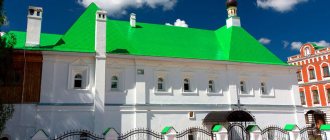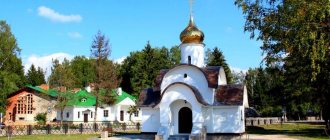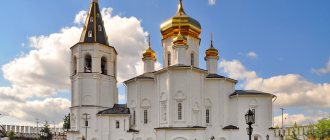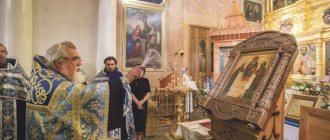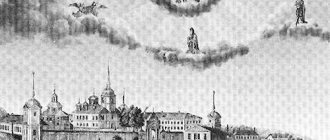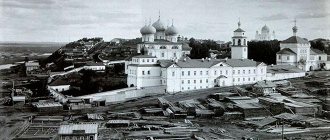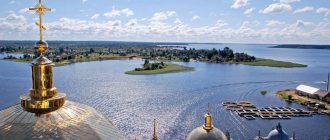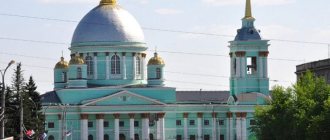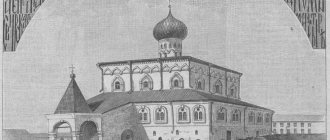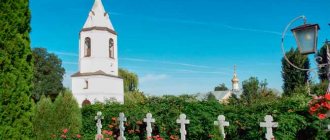| Yaroslavl Cyril Athanasiev Monastery. Photo beginning XXI century |
Yaroslavl Monastery in the name of Saints Cyril and Athanasius of Alexandria,
Yaroslavl diocese
- Address: Russia, 150000, Yaroslavl, pl. Chelyuskintsev, 17
- Tel.
- Official site:
- On the map: Yandex.Map, Google map
Base
The oldest mention of the monastery speaks of the abbot of the monastery, Vassian, around 1570.
However, there is no other evidence of the existence of the monastery before 1615. The founding - or resumption - of the monastery that year is associated with a miraculous event during the troubled times [1]. At the end of March 1612, the people's militia of Prince Dimitry Pozharsky and Kozma Minin arrived in Yaroslavl to gather forces. Due to the large concentration of troops in the city, a pestilence began and many died. Residents turned to the “former cathedral church of the Assumption of the Blessed Virgin Mary, Archpriest Ilya” with a request to organize a religious procession with the Tolga Icon of the Mother of God. But the Savior appeared to Archpriest Ilya in a dream and ordered him to lift up, along with the others, the icon of the Savior Not Made by Hands, which was kept in dust and oblivion in a chapel near the wooden church in the name of Saints Athanasius and Cyril of Alexandria. When Father Ilya woke up and found the icon in the chapel, he did not see a speck of dust on it. He doubted, but when he fell asleep, the Lord appeared to him again and commanded him to “ take this icon from here without hesitation, and walk around the city with it, and perform litias with prayer singing.”
“Which Ilya did with great zeal, announcing what had happened to all the people gathered in the cathedral square. During the religious procession, a miracle occurred - the healing of a blind man who was begging for alms. The second miracle from this icon occurred when the procession reached the chapel where the icon had previously been located: the people carrying the icon could not move. Amazed by this miracle, the residents of Yaroslavl decided to build an ordinary church in honor of this icon. After this event, the pestilence in the city ceased.
In 1615, the zemstvo elder Gabriel Myakushkin, with the support of “ other zealous zealots of the holy cause
"turned to Metropolitan Kirill (Zavidov) of Rostov for his blessing to build a monastery on a place sacred to the townspeople, where the icon was found. The monastery opened in the same year and has been governed by abbots since then.
In the 17th century
Tsar Mikhail Feodorovich treated the monastery favorably and gave it ownership of three villages, fishing grounds on Lake Uschemer, as well as tax benefits. The sovereign's charter of 1619 stated:
«in that Afanasyevsky Monastery there is no salary of ours, no money or grain, and nothing goes for candles and incense and church wine, and for this purpose they were given a place for a mill on the Yaroslavl and Romanovskaya side. And that they will transport the forest and firewood along the Volga and along Mologa and along Sheksna for monastic use, and from that forest they will wash and collect duties
.»
In addition, from the monastery estates “ no taxes and any monetary extortions and Cossack grain reserves and fodder should be given to the people, except for Yamsky money and Streltsy grain reserves and city and prison affairs
", "monastery peasants were also freed from trial, "
except for murder and robbery and red-handed theft
," the right of trial remained only with the sovereign and the abbot, "
with his brothers
."
In addition, the monastery was freed from the habitation of princes, boyars, governors and military men, and if someone comes to a feast or brotherhood to drink uninvited, they will send that uninvited person out of the yard without a song, but if he doesn’t listen and won’t go out and force them to drink heavily , and what destruction will happen to them at that feast, and that uninvited person will have to pay double for his death without trial and without truth
.”
According to the second charter, dated May 7, 1623, the monastery was granted possessions near Yaroslavl, on the other side: the villages of Ivanovo, Kovshovo, Dikushi with 227 souls of peasants, as well as fishing grounds on Lake Uschemer and a “hermitage,” where it was ordered to build the Church of Paraskeva Pyatnitsa and “set the singing.”
In response to the petition of 1627, the tsar, in addition, granted a charter according to which henceforth monastery people “ were not ordered to be employed as kissers.”
.»
The early monastery buildings were made of wood; the monastery burned down in fires more than once in the 17th century. Thus, the chronicle record says that in 1658 “ the Monastery of the Image of Our Jesus Christ Not Made by Hands, which we call Athanasievsky, was completely destroyed by fire
.»
The first stone church of the monastery in the name of Saints Athanasius and Cyril was erected in 1664. In the fire of 1670, the monastery was damaged again. In 1676, a warm chapel was added to the northern façade of the cathedral church in the name of Metropolitan St. Alexy of Moscow.
The territory of the monastery was small, surrounded by a low stone wall only on the eastern and northeastern sides. On other sides, the monastery fence was replaced by “ outbuildings of philistine houses and the Spaso-Proboinskaya Church
.»
Synodal period
In the 18th century, two small stone towers were built on the front eastern façade of the monastery, facing Proboynaya Street, one of which served as the Holy Gate, and in the other a chapel was built in memory of the discovery of the miraculous icon of the Savior Not Made by Hands.
During the secularization reform in 1764, by decree of the empress on March 31, the monastery was classified as supernumerary. In the same year, the monastery received utensils from the abolished Alexander Hermitage near Rybnaya Sloboda.
On June 25, 1768, a fire broke out again in the central part of Yaroslavl, in which both churches, the abbot's and monastery's cells, the kitchen, the stable, the carriage house, the bathhouse, the cellars, and the monastery's fence were damaged by the fire. And “ the total amount of 1000 rubles that was burned and broken in the Afanasyevsky Monastery”
.»
In 1773, the abbot of the monastery was granted participation in the annual carrying of the miraculous Yugskaya Icon of the Mother of God from the Yuga Dorotheev Hermitage to Uglich, Rybnaya Sloboda (now Rybinsk) and Mologa.
In the 1820-1830s, significant work was carried out at the monastery to improve it: “ in connection with the northern wall
“stone two-story abbot’s chambers with an adjacent refectory were built;
“ in connection with the eastern fence
” - two monastic cells; renovations also affected the main temple of the monastery. At the same time, the monastery was given a 115-pound bell from the abolished Boris and Gleb parish; in total, the bell tower ensemble consisted of seven bells.
On December 12, 1857, the emperor approved a synodal resolution on raising the monastery to the level of a third-class monastery, from which time its abbots had the rank of archimandrites. The most significant work on the improvement of the monastery was carried out in the 19th century, when the abbot's chambers and fraternal cells were built, the iconostasis and paintings of the saint's church were updated. The most generous benefactor of the monastery was Ivan Aleksandrovich Vakhromeev, with whose funds major repairs were repeatedly carried out at the monastery. His relatives and descendants continued to patronize the monastery.
| Yaroslavl Cyril Athanasiev Monastery. Photo ok. con. XIX-early XX centuries |
Since 1895, the monastery became the residence of the suffragan bishop of Uglich.
The monastery again underwent reconstruction at the turn of the century: in 1897, stone cellars, a barn, a carriage house, a stable, and a bathhouse were erected; At the beginning of the century, work was carried out on the cathedral church.
According to the custom that developed towards the end of the synodal period, every year on May 2, on the day of memory of Athanasius of Alexandria, a procession of the cross took place from the Yaroslavl Assumption Cathedral to the monastery. The monastery was widely known, its churches were constantly filled with worshippers.
Abolition and desolation
In the post-revolutionary years, a parish community was registered at the monastery, which was mentioned for the last time in 1923. In February 1925 the monastery was closed. At the same time, part of the “dilapidated religious property” was transferred to the Church of the Savior on the City and a number of other churches.
In the 1930s, the city authorities dismantled the monastery bell tower, various enterprises were set up in the churches and cells of the brethren, in particular, the administration of a furniture factory was located there, and people settled in the fraternal buildings. The bell towers of both churches were destroyed, reconstructions and partitions were made inside, the paintings were painted over.
Recovery
In 2006, the Church of Saints Cyril and Athanasius became the church of the revived seminary. The Spaso-Proboinsky Church was also assigned to the seminary. When the seminarians came here, they found churches with broken windows and doors, littered with piles of rubbish. After several months of labor, the Alexievsky chapel became suitable for worship again.
In May 2007, two churches and other buildings of the former monastery were transferred to the Yaroslavl diocese. The first service in the revived church on January 31, 2008 was led by Archbishop Kirill (Nakonechny) of Yaroslavl.
On March 31, 2009, by a synodal decision, the monastery was revived. In 2010, the roof of the cathedral was repaired and the façade of the cathedral was strengthened, and the construction of the fence with towers was completed. In the summer of that year, after one of the turrets of the fence fell, the entire wall had to be dismantled brick by brick and a new one built from the same brick.
| Cathedral of the Yaroslavl Cyril-Athanasius Monastery. Photo beginning XXI century |
Temples, architecture
Cyril Afanasyevsky Cathedral
The stone cathedral in the name of Saints Cyril and Athanasius of Alexandria was built to replace the wooden one in 1664. Upon completion of construction, the temple was decorated with paintings, which were worked on by craftsmen from Moscow. In 1676, a warm chapel was added to the northern façade of the cathedral church in the name of Metropolitan St. Alexy of Moscow. The chapel was crowned with a bell tower.
During restoration work after the fire of 1768, the painting of the church was renewed, its original stone iconostasis was replaced with a wooden one. Around 1825 a new iconostasis was completed. In 1831, the warm chapel was “distributed and decorated in places with paintings,” the painting was done by the painter Timofey Medvedev.
In 1903 and 1907, repair work was carried out at the expense of F.E. Vakhromeev; in 1912, with donations from A. I. Vakhromeyev, the wall paintings of the temple were renewed by the famous artist and restorer M. I. Dikarev.
At the beginning of the 21st century, fragments of frescoes from the 17th century have survived, mostly covered with layers of plaster.
Spaso-Proboinsky Church
The wooden church in honor of the image of the Savior Not Made by Hands on Proboynaya Street burned and was restored more than once.
A little history
Researchers have not yet found out the exact date of foundation of the Kirillo-Afanasyevsky Monastery. Most believe that the monastery appeared in the city in 1615. It was on the verge of closure more than once and experienced prosperity just as many times. In 1918, during the civil war, the temple complex was seriously damaged by shelling: two churches were destroyed and a residential building burned down. In 1925 the monastery was closed.
In 2007, the buildings were returned to the Orthodox community, but with broken windows and mountains of rubbish. Restoration work is still ongoing.
Abbots
- Vassian (mentioned 1570)
- Bartholomew (mentioned 1627) builder
- Nicholas (? - 1881)
- Feodosius (Rozhdestvensky) (March 31, 1881 - February 16, 1886)
- Sergius (Voskresensky) (March 18, 1901 - March 26, 1906)
- Theodore (Cazanov) (October 22 - December 24, 2010) acting governor
…
…
…
1925 - March 31, 2009 - closed
Shrines
- the image of the Savior Not Made by Hands - a copy from an ancient miraculous icon, returned to the monastery from the Trinity Church in the village of Smolensky on January 29, 2011
- particle of the relics of St. Athanasius of Alexandria - brought on January 28, 2012
By the end of the synodal period
- the miraculous image of the Savior Not Made by Hands - revealed in 1612, remained unharmed in the multiple fires to which the Church of the Savior was subjected: the icon was found on the ashes, untouched by the flames. During Soviet times, the icon was destroyed.
- particle of the relics of St. Cyril of Alexandria - preserved in the sacristy in a silver casket
- Metropolitan icon Moscow St. Alexia - in a rich silver chasuble, installed in 1857; was in the warm Alexievsky chapel
- antimins St. Demetrius of Rostov - taught by Saint Demetrius during the consecration of the stone church in 1705; was in the Spasskaya Church
Spaso-Preobrazhensky Monastery
Video: Spaso-Preobrazhensky Monastery
Basic moments
The holy monastery, which has long been the largest spiritual center and the strongest fortress in the Moscow region, is today part of the Yaroslavl Historical and Architectural Reserve, and its ancient architectural ensembles are included in the UNESCO World Heritage List. Acquaintance with the sights of the Spaso-Preobrazhensky Monastery is included in the program of the Golden Ring tourist route and in the program of excursions for passengers of the Volga motor cruise liners.
The powerful snow-white walls of the monastery reliably protect its spacious territory from the bustle of the city. It seems that time has stopped in this quiet, cozy, well-groomed corner, and even numerous excursionists are not able to change the atmosphere reigning here. Crossing the invisible threshold of time, visitors, without saying a word, lower their voices. The beauty of ancient Russian architecture can be admired here at any time of the year: in spring and summer, when the monastery territory is buried in emerald greenery, in golden autumn, when the fruits are ripening on the apple trees of the old garden, and the flowerbeds are still decorated with the last flowers, and in the snowy winter - the time when the monastery looks especially romantic and mysterious.
The treasures of the Spaso-Preobrazhensky Monastery are represented not only by architectural monuments. There are several museums here with rich collections of icons, books, church relics, and objects of decorative and applied art. Traveling exhibitions are constantly held on the territory of the monastery; in the summer, concerts, holidays and festivals are held.
History of the monastery
The Yaroslavl Spaso-Preobrazhensky Monastery dates back to the second half of the 12th century. It was founded outside the city suburb and became part of the fortification system, protecting the city from the southwest. According to legend, the monastery was built on the land where the Velesov Temple was located - a place of worship for local residents of pagan gods.
At the beginning of the 13th century, under the first Yaroslavl prince Vsevolod Konstantinovich, the Spaso-Preobrazhensky Cathedral, a miniature Church of the Entrance to Jerusalem, was built on the territory of the monastery. A library began to be formed here, and work was carried out on copying books. However, the first wooden and stone monastery buildings were destroyed during the Mongol-Tatar invasion, and subsequently the buildings were destroyed by countless fires. Stone buildings dating back to the 16th-17th centuries have survived to this day, when the monastery was one of the most significant fortresses of the Volga region and the largest church feudal patrimony: the holy monastery was constantly growing with new lands, which were given to it by royalty and written in the wills of the God-fearing rich.
The Transfiguration Monastery witnessed the turbulent events of the early 17th century - the hard times of the civil war and the Polish-Swedish intervention. In 1609, the monastery walls withstood a 24-day siege by the associates of the “Tushino thief” False Dmitry II, preventing the enemy from breaking into their territory. In 1612, when the Nizhny Novgorod militia, led by Minin and Pozharsky, arrived in Yaroslavl, and the city actually became the capital of the Russian state, the Transfiguration Monastery, according to many historians, was the headquarters of the provisional government - the “Council of the Whole Earth”. On July 27, 1612, a 25,000-strong militia army set off from here on a liberation campaign against Moscow captured by the Poles.
During the reign of Peter I, the Holy Transfiguration Monastery began to lose its state significance, and its feudal rights were gradually curtailed. The holy monastery suffered even more economically during the period of secularization initiated in the 60s of the 18th century by Empress Catherine II. To top it off, in 1763, one of the worst fires in its history occurred in the monastery. The 20,000 rubles allocated by the Empress from the state treasury for the restoration of the monastery buildings became the last major contribution in its history. In 1788, the highest decree was issued on the transformation of the Spaso-Preobrazhensky Monastery into the Yaroslavl Bishop's House. It is worth saying that by the time of its final abolition, the monastery had about 14,000 thousand peasant souls, as well as more than 30 villages and 500 hamlets.
In subsequent centuries, many ancient monastery buildings were demolished, but new buildings were built. Among them are the Seminary building, the church of the Yaroslavl wonderworkers Fyodor, David and Constantine, the Smolensk chapel, the cell building, and the sacristy.
In 1918, after the brutal suppression of the White Guard rebellion in Yaroslavl, the Soviet government closed the bishop's house. Restoration workshops are located on the territory of the monastery. But for some time several monks continued to live here, acting as guardians of the church sacristy. However, the treasures of the ancient monastery were still plundered. Contemporaries testified that the famous library of the monastery, where in 1795 the historian Musin-Pushkin discovered the handwritten literary work “The Tale of Igor’s Campaign,” was often visited by lovers of antiquities without security, after which many valuable books disappeared.
In the 30s, restoration work stopped, and various institutions were located on the territory of the monastery, some premises were used as residential premises. Later, the military settled here, occupying the former monastic property until 1949. In the 50s, the restoration of ancient monuments resumed, and in 1959, the Yaroslavo-Rostov Historical, Architectural and Art Museum-Reserve was located on the territory of the Spaso-Preobrazhensky Monastery, renamed 70 years in the Yaroslavl Historical and Architectural Museum-Reserve.
Sights of the Spaso-Preobrazhensky Monastery
Like many centuries ago, the Spaso-Preobrazhensky Monastery is surrounded by powerful walls that make up an irregular pentagon, and their corners are crowned by picturesque towers. The main entrance to the monastery, as before, is the Holy Gate, protruding from the southern wall and facing the embankment of the Kotorosl River. Decorated with a coil belt, they were built in 1516. Their vault was painted back in 1564, but a century later the craftsmen replaced the painting. The theme of creation is the Apocalypse (“Vision of the Apostle John the Theologian about the future destinies of the world”). The Holy Gate is the only one of the monastery towers that has survived from the 16th century. Other ancient towers also deserve inspection: Bogoroditskaya (1623), built on a deep basement with a secret passage, Uglich passage tower, erected in 1635 on the territory of the settlement, which, by the way, caused discontent among the townspeople and even led to hand-to-hand battles with monastery servants. The Mikhailovskaya and South-West towers date back to the beginning of the 19th century.
The most ancient architectural monument not only of the monastery, but of the whole of Yaroslavl is the Transfiguration Cathedral, the construction of which dates back to 1506-1516. According to the latest data, Italian architects who took part in the construction of the Moscow Kremlin worked on its project.
This four-pillar, three-domed cathedral is built on a high basement and is surrounded by open galleries. The temple in its architectural form is associatively reminiscent of the Annunciation Cathedral of the Moscow Kremlin, and its decor is reminiscent of the Archangel Cathedral in the Kremlin. The decoration of the facades of the cathedral is strict, but elegant and very elegant. The interior of the temple features remarkable frescoes created by Moscow and Yaroslavl masters, their names are imprinted in the “stamp” on the northwestern pillar. The paintings date back to 1563-1564 and are very rare. Their style reflects the monumentality, splendor, and, at the same time, the severity of the era of Ivan the Terrible.
On the western wall you can see paintings with scenes of the Last Judgment. Among them, the fresco “Procession of the Righteous to Paradise” stands out, distinguished by its light, airy design and soft outlines of the characters’ faces. The paintings on the southern and northern walls are located on three tiers, and the frescoes on the eastern wall, behind the iconostasis, on four. The upper ones demonstrate biblical and evangelical scenes, the lower ones are dedicated to the seven Ecumenical Councils. In the apses there is an image of John the Baptist, appearing as an ascetic with a hard, stern, haggard face, and the fresco “Praise of the Mother of God.” Among the most significant paintings of the cathedral is the “Transfiguration” with the central figure of Christ.
Opposite the temple there is a stela-monument “The Oath of Prince Pozharsky”.
To the east of the cathedral rises a spectacular massive monastery belfry, built in the 16th century. Previously, its northern wall was connected to the cathedral by a two-tier gallery, and in the lower floor of the belfry there was a church. The existing bell tower superstructure, created in pseudo-Gothic style, dates back to the beginning of the 19th century.
The height of the monastery belfry is 32 meters, and a narrow twisted staircase leads to its top. It’s definitely worth climbing it to get to the observation deck, which offers a magnificent panorama of the Spaso-Preobrazhensky Monastery and the ancient city of Yaroslavl. On the belfry you can see 18 bells cast between the 14th and 19th centuries. The largest of them, “Blagovestnik”, weighs more than one hundred pounds. In the summer, bell concerts are often held here.
To the west of the square in front of the cathedral there is a large refectory building, adjacent to which is the Church of the Nativity. Built in the 16th century, it was rebuilt several times, but overall retained its ancient appearance.
In the refectory chamber there was previously a dining room for the monastery brethren; food was served here from the kitchen through vertical hatches in the thickness of the walls. There were also reception rooms for noble guests here. The refectory is connected to the abbot's chambers by a huge vestibule.
On the eastern side of the Transfiguration Cathedral there is a cell building, consisting of two almost identical blocks. This building dates back to the end of the 17th century, and they were restored in the middle of the last century.
On the territory of the monastery, in an enclosure, lives the huge bear Masha, a favorite of tourists and a symbol of Yaroslavl. As a child, she was brought to the city from a remote Vologda village after her mother died at the hands of poachers. In 1990, the museum-reserve sheltered the baby, building a large enclosure for her, a house for winter sleep and a bathtub for swimming in the summer. Over time, Masha turned into a luxurious, well-groomed animal, distinguished by excellent health and appetite. To admire Masha, you need to purchase a separate ticket, but tourists do not skimp - after all, this is how they contribute to the maintenance of their favorite.
Museums of the Spaso-Preobrazhensky Monastery
The monastery museums are located in several buildings located on the territory of the ancient monastery. It displays permanent exhibitions and temporary ones provided by other museums in the country.
You should definitely visit the exhibition of ancient Russian painting to get acquainted with the school of Yaroslavl icon painting, whose golden age occurred at the end of the 16th - beginning of the 17th century. The writing style of Yaroslavl masters is distinguished by painstakingness, precise composition and a rather unique coloring. There is no blue color in the images; preference is given to ocher and brown tones with shades from pink to burgundy. Most of the icons came here from the Transfiguration Cathedral.
The exhibition “Treasures of Yaroslavl” is very interesting, presenting visitors with a collection of valuables brought from Yaroslavl monasteries and cathedrals. Here you can see rich church vestments, books, embroidered images of saints, altar crosses, chalices made of precious metals, many of which date back to the 16th century. The pearl of the exhibition is the Spassky Gospel of the 13th century.
In a separate room, frames, crowns, tsats for icons made of silver with gilding, icon and base frames of the Gospels, and carved wooden royal doors are displayed. Next is a collection of enamels from the late 18th – early 19th centuries, originating from Moscow, Rostov, and Ukrainian cities.
On the territory of the Spassky Monastery there is also a museum dedicated to the poetic chronicle “The Tale of Igor’s Campaign.”
Among the permanent exhibitions of the Spaso-Preobrazhensky Monastery are “History of the Yaroslavl Region” and “YarmaNka”, dedicated to the history of fairs in the Yaroslavl Region.
Practical information
The Spaso-Preobrazhensky Monastery is located in the Kirovsky district of Yaroslavl at the address: Bogoyavlenskaya Square, 25.
You can go on a tour of the Spaso-Preobrazhensky Monastery any day of the week. From May to September its doors are open from 8:00 to 20:00. Museums are open from 10:00 to 17:45. From September to April, you can visit the monastery from 9:00 to 18:00, museums from 10:00 to 17:45.
On rainy days, architectural monuments may not be accessible to visitors. This is due to the recommendations of restorers who insist on observing the conditions for the preservation of fresco painting.
The entrance to the monastery runs through the Holy Gate tower. There is a free parking lot nearby. There is a through exit through the North Gate. The ticket office is located next to the entrance.
A single ticket for an adult on a weekend costs 700 rubles, on weekdays – 500 rubles. Reduced ticket for students over 16 years old, students, pensioners of the Russian Federation - 300 and 250 rubles, respectively. If you do not plan to see all the attractions and exhibitions, determine in advance what exactly you want to see and what exhibitions are currently taking place there, as visiting each site and event has a separate cost and will require a separate ticket. Tourists who do not take care of the necessary tickets are often forced to return to the ticket office, where, as a rule, there are long lines, especially on weekends.
Those who want to just stroll through the beautiful territory of the Spaso-Preobrazhensky Monastery without visiting its attractions can pay only 40 rubles. A sightseeing tour of the territory, lasting half an hour, will cost 100 rubles.
On the territory of the monastery there are cafes, stalls selling water, a children's playground, and a paid toilet. There are many kiosks here selling souvenirs, the most popular of which are products made from Yaroslavl majolica - cute, fabulous and cheerful.
